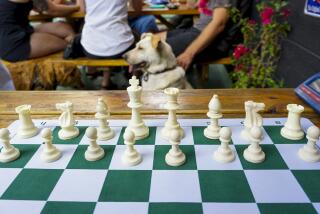Dutch tournament ends today
Jan. 31, 2010
Position No. 6092: Black to play and win. From the game Jozsef Pinter-Fabian Platzgummer, Austria 2010.
Solution to Position No. 6091: Black wins a piece by 1 . . . Nf4+ 2 Kh6 (not 2 Kh4? Bf2 mate) Nd5+ 3 Kh5 (not 3 Kh7? Nf6 mate) Nf6+ 4 Kh4 Bf2+ 5 Kh3 Rg3+ 6 Kh2 Ng4+ 7 Kh1 Ne3 8 Be6 Rg7. Instead, 6 Kh4 allows mate by 6 . . . Rg7+! 7 Kh3 Nh5! 8 Kh2 Nf4 9 Bc2 Rg4.
The Corus tournament ends today in Wijk aan Zee, Netherlands. You can watch the final round live at coruschess.com.
A great tournament alters the pecking order of the leading grandmasters. Two of the favorites, former world champion Vladimir Kramnik and contender Magnus Carlsen, enhanced their reputations, while world champion Viswanathan Anand fell back by drawing his first nine games.
The biggest gainers were Alexey Shirov, who began with five consecutive wins, and U.S. champion Hikaru Nakamura, who knocked off Shirov before losing to Kramnik.
Local news
Tatev Abrahamyan scored 5-0 to win the 37-player Orange County Open last weekend at Hanley Chess Academy in Huntington Beach. She notched wins over Gregg Fritchle and IM Emory Tate, who tied for second at 4-1 with Yusheng Xia. Yuuki Matsumoto won the 25-player scholastic event.
The Santa Monica Bay Chess Club will begin a four-round tournament at 7 p.m. Monday. The club meets every Monday evening in St. Andrew’s Lutheran Church, 11555 National Blvd. in Los Angeles. Call Pete Savino at (310) 827-2789 for more information.
The Exposition Park Chess Club, which meets every Sunday in the public library, 3900 S. Western Ave. in Los Angeles, plans a free tournament, open to all, at 1 p.m. next Sunday. See chess.expoparkla.com for more about the club.
The U.S. Amateur Team West, one of the most popular local tournaments, will be held President’s Day weekend, Feb. 13 to 15, at the Warner Center Marriott, 21850 Oxnard St. in Woodland Hills. To join a team, go to westernchess.com.
Today’s games
GM Hikaru Nakamura (USA)-GM Loek Van Wely (Netherlands), Wijk aan Zee 2010: 1 e4 c5 2 Nf3 d6 3 d4 cxd4 4 Nxd4 Nf6 5 Nc3 a6 6 Bg5 The sharpest treatment of the Najdorf Sicilian. e6 7 f4 Nbd7 Black keeps more options by delaying . . . Bf8-e7. 8 Qf3 Qc7 9 Bxf6 Nxf6 10 g4 b5 11 g5 Nd7 12 0-0-0 Welcoming the old main line, 12 . . . Be7 13 f5. Nc5 Reasonable, and less investigated. Too dangerous is 12 . . . b4?! 13 Nd5! exd5 14 exd5, while 12 . . . Bb7 13 Bh3 Rc8 14 Rhe1 leaves e6 vulnerable to a sacrifice or to f4-f5. 13 a3 The hasty 13 f5?! b4 favors Black. Rb8 14 b4 New. Nd7 After 14 . . . Na4 15 Ndxb5! axb5 16 Bxb5+ Rxb5 17 Nxb5 Qb6 18 Qd3 Bd7 19 Nxd6+ Bxd6, the finesse 20 Rd2! avoids 20 Qxd6? Qe3+ and recovers material advantageously. 15 Nd5! A promising version of a standard sacrifice. exd5 Declining doesn’t help, as 15 . . . Qb7 16 Qc3 forces 16 . . . exd5 17 exd5 Nb6 18 Re1+ Be7 19 Nc6 Nxd5 20 Qxg7. Then 20 . . . Rf8 21 Nxe7 Nxe7 22 Bd3 leaves Black helpless against f4-f5-f6. 16 exd5 Be7 Black will return material to castle. However, 16 . . . Bb7 17 Qe3+ Kd8 18 Bg2 appears best. Then 18 . . . Be7 19 Rhe1 Re8 20 Nf5 Rc8 21 Re2 Qc3! 22 Qxc3 Rxc3 23 Rde1 Rxa3 gives Black adequate counterplay. 17 Re1 Ne5 The other plausible defense, 17 . . . Nb6 18 Nc6 Nxd5 19 Qxd5 Be6, lets White attack with 20 Nxe7 Qxe7 21 Qd2 g6 22 h4. 18 fxe5 Bxg5+ 19 Kb1 dxe5 20 Nc6 Bf6 21 Bd3 Correctly preferring the initiative to material gain by 21 Nxb8 Qxb8 22 Bd3 Qd6, when White cannot easily break through. h5? Sturdier is 21 . . . Rb6, setting the trap 22 Nxe5?? Bxe5 23 Qh5 g5! 24 Qxg5 f6. But it’s difficult to find a move for Black after 21 . . . Rb6 22 Rhf1 Bb7 23 Be4, because 23 . . . Bxc6 24 dxc6 would let White bring a Rook to d7. 22 Rxe5+! Bxe5 23 Re1 Bg4 24 Qf4 0-0 White refutes 24 . . . f6 precisely by 25 Bg6+! Kd7 26 Bf5+! Bxf5 27 Qxf5+ Ke8 28 Qe6+ Kf8 28 Nxe5. 25 Rxe5 Inviting 25 . . . Rbe8? 26 Rxe8 Qxf4 27 Ne7+ Kh8 28 Rxf8 mate. g6?! Tougher is 25 . . . f5 26 Nxb8 Qxb8, although 27 Qd4, threatening 28 Re7 and 28 d6, is irresistible. 26 Qf6 Rbe8 27 Ne7+ Rxe7 Or 27 . . . Kh7 28 Bxg6+, mating. 28 Rxe7 Qxh2 29 Bxg6 Qh1+ 30 Kb2 Qxd5 31 Bxf7+ Simplifying to an easy endgame. White could win in the middlegame by 31 Be4 Qd2 32 Bd3!, with the unstoppable threat of Re7-e5-g5. Qxf7 As 31 . . . Rxf7 permits 32 Re8+. 32 Rxf7 Rxf7 33 Qxa6 Kg7 34 Qxb5 Kg6 35 Qc4 Rd7 36 b5 Kg5 37 b6 Bf3 38 Qb5+ Rd5 39 Qb3, Black Resigns.
GM Giovanni Vescovi (Brazil)-GM Teimour Radjabov (Azerbaijan), World Team Championship, Bursa 2010: 1 d4 Nf6 2 c4 g6 3 Nc3 Bg7 4 e4 d6 5 Nf3 0-0 6 h3 An odd line against the King’s Indian Defense. e5 7 d5 The position resembles the Petrosian system, but with h2-h3 instead of Bf1-e2. Nh5 8 g3 a5 Patient. If 8 . . . f5, White can strive for the initiative with 9 exf5 gxf5 10 Ng5 Nf6 11 g4. 9 Bg2 Logical, but untested. White has previously tried to embarrass the Knight at h5 by 9 Be2 or 9 Nh2. Na6 10 0-0 Nc5 11 Be3 Bd7 12 Ne1 b6 13 Kh2 Qe8 Preparing . . . f7-f5. White must act. 14 Bf3 f5! 15 exf5! e4 16 Be2! Ambitious. After 16 Bxh5 gxh5, White cannot hold the pawn by 17 g4?, as 17 . . . hxg4 18 hxg4 h5 destroys his Kingside. But 17 Bd4 Bxf5 18 Bxg7 Kxg7 19 Ng2 keeps chances about even. Bxf5 There is no choice. Black is committed to a speculative attack with heavy sacrifices. 17 g4 Accepting the challenge. The quiet 17 Nc2 Be5 18 Nd4 Ng7 would not disturb Black. Qe5+ 18 Kg1 Not 18 Kh1? Ng3+! 19 fxg3 Qxg3 20 Ng2 because Black wins with 20 . . . Bd7 (threatening 21 . . . Be5) 21 Bf4 Qxh3+ 22 Kg1 Nd3, setting up 23 . . . Bd4+. Nf4 19 Bxf4 Probably stronger than 19 gxf5 Nxh3+ 20 Kh1 gxf5 21 f4 Qe7, when Black will follow with . . . Rf8-f6-h6. Qxf4 20 Ng2 Not 20 gxf5?? Be5. Qh6 21 gxf5 gxf5 22 f4!? The alternative is 22 Qc1!? f4 23 Bg4 Kh8 24 f3 e3. White’s King will be safe unless Black can advance . . . h7-h5 and use the g-file. Qxh3 23 Qd2 Kf7 24 Rfe1?? Definitely losing. The critical variation is 24 Qe3! Bd4! 25 Qxd4 Rg8 26 Rf2 Rg6! (worthless is 26 . . . e3? 27 Bh5+! Qxh5 28 Qxe3) 27 Bf1 Rh6 28 Rd2 Rg8 29 Kf2 Qf3+ 30 Ke1 Rh1. White cannot stand 31 Qf2? Rxg2! 32 Qxf3 exf3 33 Rad1 Ne4, but 31 Ne3! Rgg1 32 Rf2 Qg3 33 Ke2 Nd3 34 Nxf5 Qg4+ 35 Kd2 Nxf2 36 Ne3 Qh4 37 Ne2 shields the King and secures a small advantage. Rg8 25 Bf1 Nd3! With the devastating threat of 26 . . . Bd4+. 26 Nb5 No better is 26 Ne2 Bf6!, when the Bishop heads for f2. And 26 Qe3 loses too much material to 26 . . . Qxe3+ 27 Rxe3 Bd4 28 Nd1 Nxb2. Bh6! 27 Re3 After 27 Qe3 Qh4, White cannot hold back 28 . . . Bxf4. Nxf4! 28 Rxh3 Nxh3+ 29 Kh2 Bxd2 30 Kxh3 Rg5 The attack continues, despite the reduction in material. 31 Rd1 Rag8 32 Rxd2 Rh5+ 33 Nh4 Rg4 34 Kh2 Rgxh4+ 35 Kg1 Or 35 Kg3 f4+ 36 Kf2 e3+. Rh1+, White Resigns. After 36 Kf2, Black may choose 36 . . . e3+ 37 Kxe3 Rxf1 or, even better, 36 . . . R5h2+ 37 Bg2 f4.

